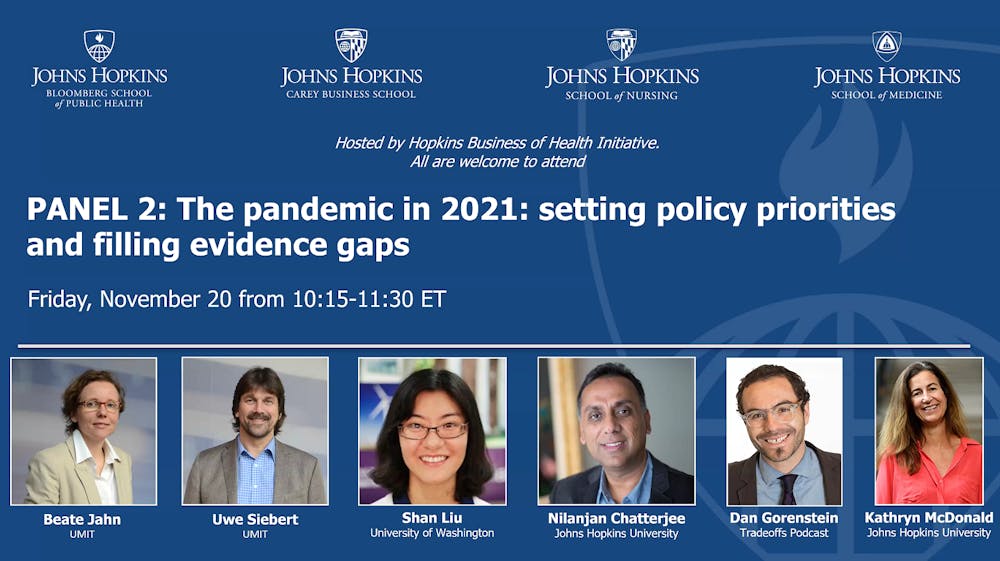With the introduction of COVID-19 vaccines, individuals, clinical professionals, public health leaders and policy-makers must contend with steep trade-offs and high-stake dilemmas.
What is the optimal sequence of vaccine distribution? Should some groups, like the elderly, be prioritized over others, like health-care workers? Should social equity be considered in addition to deaths and hospitalizations?
To help answer these questions, the second panel of the Nov. 20 COVID-19 Symposium at Hopkins, titled “Navigating the pandemic when effective vaccines are in the toolbox,” hosted mathematicians and biostatisticians who model various scenarios to aid in decision-making.
Each of the three models presented by panelists offered different perspectives to bring an end to the pandemic: the impact of non-pharmaceutical interventions, the optimal sequence of vaccine distribution and risk projections on the individual and community-level.
Shan Liu, an associate professor at the University of Washington, modeled the effects of non-pharmaceutical interventions, like face mask use, social distancing, school closures and contact tracing. Her team tested hundreds of combinations of various rates of compliance. They found that face mask use was key.
“High compliance for face mask use is the most important driver for keeping total infections low,” she said. “Society and schools may reopen if 75% to 100% of the population use face masks.”
Her team also analyzed COVID-19 cases in King County, a county that includes Seattle. Their simulations found that social vulnerability in a community correlates with total infection rates. Social vulnerability is based on the socioeconomic and racial composition of the community.
Liu plans to continue to modify the model to inform vaccine rollout programs, an issue that Beate Jahn and her colleagues have begun to address with their models. Jahn is an assistant professor at the University for Health Sciences, Medical Informatics and Technology (UMIT) in Austria.
Jahn and her colleagues modeled the optimal sequence of vaccine administration to five groups: the elderly, middle-aged, vulnerable, young and health-care workers.
“We simulated vaccination of 200,000 people in one of the five groups and calculated long-term outcomes on the entire population,” she explained. “By administering the first vaccine doses to the elderly, we can achieve the largest reduction in deaths and hospitalization — about 5% reduction in the entire population.”
Their preliminary results suggest that priority should be given to those older than 65 years, then vulnerable people, middle-aged people, health-care workers and finally those 15-44 years old.
However, Jahn acknowledged a limitation in the model — it only considers hospitalizations and deaths. Occupational safety of essential workers, which fall under the ethical principle of risk-compensatory justice, are not taken into account.
“Protecting health-care workers may be essential to keeping the quality of the health-care system and preventing a collapse of the system,” she said.
Nilanjan Chatterjee, a Bloomberg Distinguished Professor at the School of Public Health, took a different approach to determining the optimal distribution of vaccines. His team created a general population and individual-based model for risk of COVID-19 mortality. The model may be useful to distribute vaccines equitably, targeting high-risk individuals.
They created a risk calculator that is open to the public. It incorporates the individual’s age, gender, race and various health conditions. The individual’s location is used to estimate their experiences of measures in the Index of Multiple Deprivations. All the factors are used to calculate a risk score for the individual.
“We combine the individual-level information with community-level dynamics to produce an absolute rate of mortality for the individual,” he explained.
They used their results to create a map with risk projections for the general adult population across 477 U.S. cities.
“We hope the tool will be useful for local policy-makers to decide how much vaccine supplies are needed at the local level, based on the makeup of the population,” Chatterjee said.
Harnessing the skills of decision-modelers like Chatterjee is only the first step, according to Uwe Seibert, a professor at UMIT.
“When we make decisions, we have to look at the differences between models, the few percentage points which represent lives that we can save. Then we have to balance them, and that’s tough,” Siebert said.
Sibert highlighted a mix of ethical principles which must be considered: utility maximization, equity and deontology. These principles may point to diverging paths. If the goal is utility maximization, then the elderly should be prioritized in vaccine distribution since it will lead to the most lives saved. But if the goal is deontology, or our duty as a society, then individuals who face significant occupational hazards or who are important for national security should be given priority.
Dan Gorenstein, the host of the Tradeoffs podcast, called the process “rationing health care.” He noted that it is a difficult concept for health policy makers and the general public to accept.
“People sometimes think that the health-care system should offer perfect solutions without downsides,” he said.
To help navigate the tradeoffs, the work of the experts like Liu, Jahn and Chatterjee have been, and continue to be, critical for policy makers.
“[The panelists] incorporated real decision questions that must be answered now, or maybe [should have been answered] yesterday,” Siebert said. “Some of these models are on the desks of departments of health and ministries in many countries already.”





